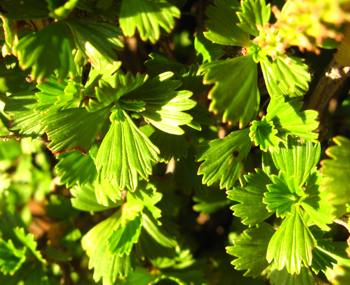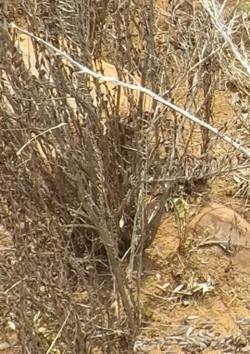Myrothamnus flabellifolius
Myrothamnus flabellifolius Welw.
Family: Myrothamnaceae
Common names: resurrection plant (Eng.); opstandingsplant (Afr.); uvukakwabafile (isiZulu); umazifisi (Ndebele)
Introduction
The leaves of the resurrection plant shrink and appear to be dead in the dry season, but miraculously turn green within a few minutes after exposure to water. The habit persists, even when the stems have been picked some time ago. The English and Zulu names refer to this remarkable property.

Description
Description
Myrothamnus flabellifolius is a small resinous shrub let, about 0.2- 1.2 m in height. It occurs singly or in colonies with extensive root systems that extend into the crevices of the rocky outcrops with soil depths of around 15cm. Its roots are able to intercept water draining into these hollows after rainfall, thereby initiating re-hydration.

Its leaves are opposite, with broad tips, wavy, folding fan-like, with the stalk sheathing at the base forming a joint with the blade. The stem is rigid, much branched and aromatic.
The plant is dioecious, meaning the male and female reproductive organs are borne on separate individuals of the same species. The tiny flowers, without calyx or corolla, are borne in small catkin-like inflorescences usually occurring on short lateral branches. The male flowers, which consist of three to six stamens with reddish anthers that dehisce (split open) longitudinally, produce abundant amounts of yellow, tricolpate (having three openings) pollen grains at maturity. The female flowers are zygomorphic (irregular) and consist of three basally attached carpels (organs which enclose the ovules and become part of the fruit) with papillose (covered with soft, nipple-shaped bulges), spathulate (spoon-shaped) stigmas that are reddish-purple and feather-like in appearance. Flowering occurs from September to November.
The fruits are three-lobed, leathery, dehiscent capsules, which are slightly larger than the carpels at anthesis.
Conservation Status
Status
Myrothamnus flabellifolius is listed on the Red List of South African plants 2009 as Data Deficient - Taxonomically Problematic (DDT). A species is DDT when taxonomic problems hinder the distribution range and habitat from being well defined, so that an assessment of risk of extinction is not possible.
Distribution and habitat
Distribution description
M. flabellifolius is a geophyte possessing an extensive root system which extends into the crevices of the rocky slopes on which it grows. It usually forms large stands in shallow soil on sunny rocky hills or along cracks and crevices in rocks. It is not endemic to South Africa, and is distributed from Cape to Kenya. Provincially in South Africa, it is distributed in Gauteng, KwaZulu-Natal, Limpopo, Mpumalanga and the North West.

Derivation of name and historical aspects
History
There are two species in the genus: Myrothamnus flabellifolius from arid mountains in Sub-Saharan Africa, and M. moschatus from Madagascar. These two species have a taxonomic family all to themselves: the Myrothamnaceae. Myrothamnus - from the Greek word myron meaning 'perfume'; thamnus meaning 'bush' and flabellifolia meaning 'with fan-like leaves'. The plant was named and first recorded in 1859 by Friedrich Welwitsch.
Ecology
Ecology
The resurrection plant is generally wind pollinated. Beetles have been observed chewing the leaves and pupae have been found attached to plant stems. The seeds, which are 0·3 to 0·5 mm long are wind-dispersed.

Uses
Use
Myrothamnus flabellifolius is unique, being the only woody resurrection plant. It is an important plant in southern Africa because of its widespread occurrence and usage in African medicine and traditional culture. The leaves contain essential oils, mainly camphor and eucalyptol and have been used as a medicinal tea. The leaves and stems of the resurrection plant are added to tea to flavour it, and are also used as a spice. Smoke from burning plants is inhaled or young leaves are smoked in pipes for asthma and pains in the chest by the Pedi people. Smoke from the leaves is directed into the vagina for pain in the uterus. The Vhavenda use the whole plant for colds, respiratory ailments, nosebleeds and fainting. In Tanzania, the fruit is used for chest complaints and the leaves are used to make aromatic lotions. The plant is used as a tonic and for breast diseases in central Africa and for a variety of complaints in Zimbabwe.
Growing Myrothamnus flabellifolius
Grow
Myrothamnus can be propagated by seed and cuttings. The seeds are tiny. Sow them, right on the surface, in a pot with a loose peat moss and perlite mix (acid to alkaline soils). The plants come primarily from summer-rainfall areas, so spring is probably the best time of year to get them started. Germination is easy and quick in a seed pot kept in a moist, well-lit location.
The seedlings should be kept moist, in a sunny spot with good air circulation. Initial growth is slow, but as is the case with many plants, growth accelerates as the seedlings gain some size and in two or three years Myrothamnus can become respectably shrubby. Regular applications of dilute, water-soluble fertilizer at half the recommended strength, every 2-3 weeks seem to be beneficial. The plants do best in full sun.
References
- Hutchings, A., Scott, A.H., Cunningham, A.B. 1996. Zulu medicinal plants: an inventory. University of Natal Press, Pietermaritzburg, South Africa.
- Jordaan, M. 2003. Myrothamnaceae. In G. Germishuizen & N.L. Meyer (eds), Plants of southern Africa: an annotated checklist. Strelitzia 14: 746. National Botanical Institute, Pretoria.
- Pooley, E.1998. A field guide to wild flowers of KwaZulu-Natal and the Eastern Region. Natal Flora Publications Trust, Durban.
- Van Wyk, B.-E. & Gericke, N. 2000. People's plants: a guide to useful plants of southern Africa. Briza Publications, Pretoria.
Credits
Mandisa Kondlo
Walter Sisulu National Botanical Garden
November 2013
Plant Attributes:
Plant Type: Shrub
SA Distribution: Gauteng, KwaZulu-Natal, Limpopo, Mpumalanga, North West
Soil type: Sandy, Loam
Flowering season: Spring
PH: Acid, Alkaline
Flower colour: Yellow
Aspect: Full Sun
Gardening skill: Average
Special Features:
Horticultural zones











Rate this article
Article well written and informative
Rate this plant
Is this an interesting plant?
Login to add your Comment
Back to topNot registered yet? Click here to register.